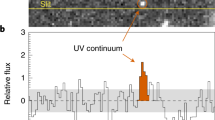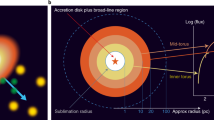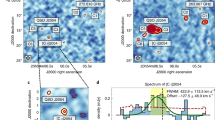Abstract
The radio source G227.1 + 1.0 (ref. 1) was observed in a search for young galactic supernova remnants, and its peculiar structure indicated that it might be a very young remnant. Chanan et al.2, however, have recently found a bright optical object with z = 0.073 close to the radio centre, which represents strong circumstantial evidence that the source is in fact a radio galaxy. Here we present a neutral hydrogen absorption profile observed with the Very Large Array (VLA) which confirms the extragalactic nature of this object.
This is a preview of subscription content, access via your institution
Access options
Subscribe to this journal
Receive 51 print issues and online access
$199.00 per year
only $3.90 per issue
Buy this article
- Purchase on Springer Link
- Instant access to full article PDF
Prices may be subject to local taxes which are calculated during checkout
Similar content being viewed by others
References
Green, D. A. & Gull, S. F. Nature 312, 527–529 (1984).
Chanan, G. A., Helfand, D. J., Spinrad, H. & Ebneter, K. Nature 320, 41–42 (1986).
Weaver, H. & Williams, D. R. W. Astr. Astrophys. Suppl. 1, 1–503 (1973).
van Breugel, W. J. M. & Fomalont, E. B. Astrophys. J. 282, L55–L58 (1984).
Author information
Authors and Affiliations
Rights and permissions
About this article
Cite this article
Green, D., Gull, S. Neutral hydrogen absorption towards G227.1 + 1.0. Nature 320, 42–43 (1986). https://doi.org/10.1038/320042a0
Received:
Accepted:
Issue Date:
DOI: https://doi.org/10.1038/320042a0
This article is cited by
-
A revised reference catalogue of galactic supernova remnants
Astrophysics and Space Science (1988)
Comments
By submitting a comment you agree to abide by our Terms and Community Guidelines. If you find something abusive or that does not comply with our terms or guidelines please flag it as inappropriate.



